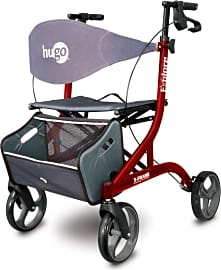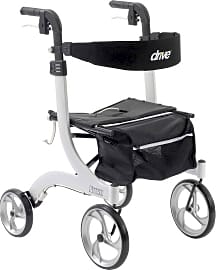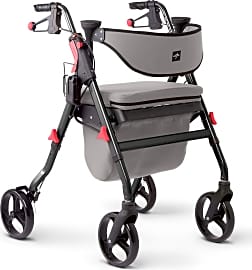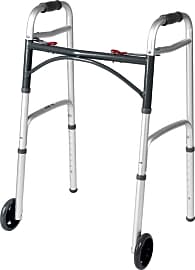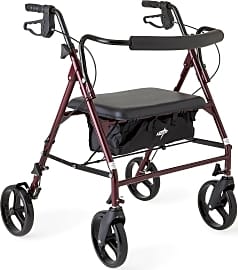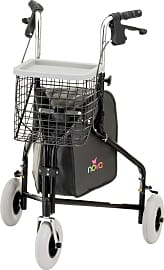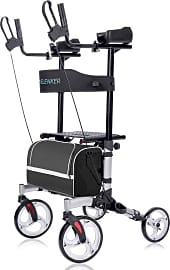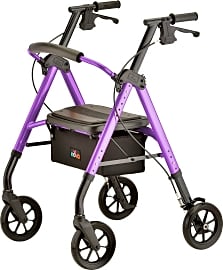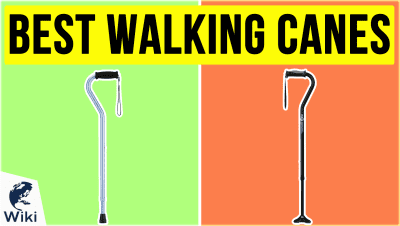The 10 Best Walkers

This wiki has been updated 39 times since it was first published in April of 2015. Being physically impaired doesn't mean you shouldn't be able to get around when you need to. If you or someone you know has temporary or permanent difficulty with mobility, try one of these walkers. They're ideal for providing independence to the elderly, infirm, or those recovering from an injury. The right rollator can significantly improve your or a loved one's quality of life. When users buy our independently chosen editorial choices, we may earn commissions to help fund the Wiki.
Editor's Notes
November 04, 2020:
In making our selections for this list, we first looked to features that would keep users safe, like brakes and anti-tip designs. We then looked for elements that improve comfort, since some individuals spend a lot of time with their walkers. If a model had additional benefits that make life a bit easier when using one of these devices, we prioritized that, as well.
Since safety was a top concern, we had to remove the OasisSpace Upright, which has unreliable brakes. In its place, we have the Nova Traveler 4900, which has highly-responsive brakes. The Nova Star DX also stood out because its brakes lock into the parked position, so users can rest on its seat, without fear of it rolling away. Another product that earned a spot due to safety features was the Comodita Prima. We think users will appreciate its very sturdy frame and the wide-set wheels that can help minimize the chances of tripping.
If you must bring a walker everywhere you go, you can't hold much else, so we saw value in any items with incorporated storage, such as the Drive Medical Nitro Euro and the HealthSmart Euro Style Rollator, both of which have detachable bags for personal belongings. The Elenker Upright has a convenient holder for a cane or umbrella, so it also caught our attention.
Should you want to take a break and sit down for a while, you might like the memory foam seat of the Medline Premium Empower, or the Hugo Mobility Explore with its large supportive backrest
November 26, 2019:
When it comes to walkers and rollators, one of the most important things is stability. If it isn't stable, it won't be safe to use, so we made that our first priority. After that we took other features including storage space, ease of folding, weight, effectiveness of the brakes, and versatility into account.
One thing you may immediately notice is that the list is mostly comprised of rollators. Given how little effort is required to brake them and the additional maneuverability they offer, most people prefer them these days over the more traditional options. That being said, we did include the affordable Drive Medical Deluxe 10210-1 for anyone who is a bit worried about using a fully wheeled walker.
When it comes to very heavy users, above the 300-pound mark, they will need a model specifically designed to handle that amount of weight. For those people, we have included the Nova Medical Mighty Mack 4216RD, Comodita Prima, and Medline Heavy Duty Bariatric, all of which can support a minimum of 400 pounds. The Nova Medical Mighty Mack 4216RD and Medline Heavy Duty Bariatric also have wider seats than most others to accommodate a little extra bulk.
If you are looking for something slightly more stylish than the average rollator, but still want something packed with features like storage space, a simple folding design, and height adjustability, the HealthSmart Euro Style, Drive Medical Nitro RTL10266-T, Hugo Mobility Explore 700, and Comodita Prima are worthy options. We will note that we find the open storage basket on the Hugo Mobility Explore 700 to be a poor design choice, since it doesn't provide any way to keep your belongings private. However, on the flip side, it does offer more storage space.
When it comes to back support in the seated position, the HealthSmart Euro Style,Drive Medical Nitro RTL10266-T, and Hugo Mobility Explore 700 are worth mentioning again, since they have a wide strap as opposed to small padded bar like many others.
Special Honors
Trust Care Let's Fly First Class The Trust Care Let's Fly First Class boasts comfortable ergonomic rubber handles with a small bump in front of the thumbs for extra stability. It has a stylish minimalistic frame and a water-resistant faux leather seat. Plus, it folds up compactly and easily and stands on its own when in the folded position. trustcare.se
Walgreens Space Saver Walker The Walgreens Space Saver Walker does what its name promises, and folds into a very compact shape that's easy to store in small areas, making it a breeze to take just about anywhere. It only weighs seven pounds, but can support up to 400, and can adjust to fit users who are between 4 feet 10 inches and 6 feet 8 inches. walgreens.com
The Right Walker For Chronic Support
Other walkers feature compartments that can be fully sealed using zippers or the unit's own seat.
If you are looking for a walker that you or a loved one will use for an indefinite period of time (and that will potentially serve as a permanent part of life), it is heartening to know that even top of the line walkers are priced well in range for most budgets.
The accessories many customers look for in a walker include things like a built in basket for carrying items while the hands are engaged, a padded seat with a back rest, and easily accessed hand brakes.
Putting budget aside, when choosing a walker for long term use, the most important factor should be the unit's ergonomics. A walker is going to serve as an extension of its user's body, so the device's design is of paramount importance. Consider things such as the angle of the walker's grips and the ease of use of its brakes. Some walkers are specially designed with brakes requiring minimal pressure, for example, which is essential for people with grip strength reduced by injury, nerve issues, or arthritis.
A walker's seat too must be comfortable for a given user, as a walker can provide essential respite when used as a seat. Some walkers have padded bars as their backrests, which might actually be uncomfortable for users with spinal or lumbar issues. Other walkers feature wider fabric bands as backrests which can distribute pressure across their user's lower torso, leading to greater comfort.
Some walker's feature open baskets which make it easy to toss in and/or retrieve the mail, a newspaper, and some groceries. These are perfect for people who use their walkers primarily indoors or for shorter outdoor strolls. Other walkers feature compartments that can be fully sealed using zippers or the unit's own seat. If you spend more time outdoors or use your walker during travels or a commute, you'll appreciate a storage area that can closed securely.
The Relatively Recent Development Of The Walker
Humans have been afflicted with mobility issues since our ancient ancestors first achieved bipedal locomotion. But it was not until the 1950s that a device allowing a user with limited mobility to remain upright, safe, and supported would finally be developed. The first unit approximating modern walkers was patented by William Cribbes Robb in the year 1953.
The walker ensured its user's stability, but was not all that easy to actually move forward.
This early walker consisted of four tubes arranged into two pairs of A-shaped frames. Atop each frame sat a handle, and each frame and handle were connected and stabilized by two bars. The walker ensured its user's stability, but was not all that easy to actually move forward.
Walkers featuring two wheels were developed later in the 1950s, and these made forward motion easier while remaining stable when at rest. In the 1970s, the first four wheeled walkers were released. Often called Rollators, these walkers were very easy to move across most hard surfaces, and were made safe and stable thanks to the addition of hand controlled brakes. Many soon featured baskets, seats, and other conveniences.
The Leading Causes Of Mobility Issues
It's too great a simplification to say that most mobility issues are caused by age. A more accurate statement would be that mobility is often impaired due to age-related conditions, but even this statement disregards many factors and casts too wide a net. This is true because, often enough, age is effectively just a number. It is the manner in which a person spent the years leading up to their current age that actually counts.
This is true because, often enough, age is effectively just a number.
In a savage irony, the more physically active a person is during their younger years, the more they may suffer from mobility issues that necessitate the aid of a cane or walker later in life. An extreme example of this would be the professional athlete who sees his or her body repeatedly damaged through acute injuries or else compromised by the repetitive stresses put on their joints and bones by the years of intense practice and play.
On the other hand, a life spent in a largely sedentary pattern can also lead to extreme mobility issues later in life as musculature needed to support the body spends years in an atrophic state. A sedentary lifestyle can also have an effect on mobility at any age, though, especially when other factors, such as obesity or disease are involved. There is a hackneyed but not inaccurate colloquialism to be heeded: one must "use it or lose it" when it comes to mobility and health.
Mobility issues not related to age or lifestyle usually come in the form of injury or illness. Damage to a knee or ankle can dramatically limit a person's ability to walk and can require protracted time to heal, as of course can any broken bone in the hip, leg, or foot. So too can less obvious issues require mobility assistance, such as nerve related conditions including fibromyalgia or ataxia. These are all issues which can affect people of almost any age equally.
While many health conditions affect the elderly in ways they may not restrict younger people, later life mobility issues are often caused by conditions present throughout a person's lifetime. Thus choices we make today can have a dramatic effect on our mobility later in life.



